UK: Narrow-bordered Bee Hawkmoth, F: Sphinx Bombyliforme; Sphinx de la Scabieuse, D: Skabiosenschwärmer, RUS: Shmelevidka skabiozovaya, S: Svävflugelika Dagsvärmare, NL: Glasvlerkje; Hommelvlinder, CZ: Dlouhozobka zimolezová; Dlouhozobka chrastavcová, H: pöszörszender, PL: Fruczak trutniowiec, FIN: Ruusuruohokiitäjä; Ruusuruohonpäiväkiitäjä, I: sfinge della scabiosa; sfinge bombiforme, HR: uskorubi bumbarasti ljiljak, DK: Smalrandet humlebisværmer, N: Smalkantet humlesvermer, EST: Harilik lottsuru.
Sphinx tityus Linnaeus, 1758, Syst. Nat. (Edn 10) 1: 493.Type locality: Unspecified [Europe].
(Taxonomic notes. (i) Derzhavets (1984) considered 'subsp.' alaiana Rothschild & Jordan, 1903, from the Alai range (Alayskiy Khrebat) of the western Tian Shan (Tajikistan), to be merely a form of Hemaris tityus, at best a subspecies. However, Eitschberger & Churkin (2002) quite rightly treat Hemaris alaiana as a distinct species. Comparison of both male and female genitalia indicate that Hemaris alaiana has evolved from an isolated population of the eastern Palaearctic Hemaris radians (Walker, 1856).
(ii) Recent DNA barcoding studies indicate that Hemaris galunae (Eitschberger, Müller & Kravchenko, 2005) from the Levant is a good species closely related to Hemaris tityus. It appears to be the eastern remnant of a species which once occurred right across a cooler, greener and wetter North Africa during the last ice age. The western remnant appears to be Hemaris aksana (Le Cerf, 1923) from the mountains of Morocco.)
(iii) Hemaris saldaitisi (Eitschberger, Danner & Surholt, 1998) was synonymized with Hemaris tityus by Kitching & Cadiou, 2000, Hawkmoths of the world: 48. Implicitly reinstated as a species by Eitschberger, Kravchenko, Li, Speidel, Witt & Müller, 2005, Atalanta 36: 203. Hemaris saldaitisi was distinguished from Hemaris tityus on the basis that the forewing marginal band was narrower, that of the hindwing was almost absent, the right harpe was flat, rather elongate and straight, with a barely enlarged apex, and the phallus was slightly longer. Kitching & Cadiou (2000) (STI 18788) considered these diagnostic features all fell within the range of individual variation of Hemaris tityus and synonymized Hemaris saldaitisi with that species. Eitschberger et al. (2005) (STI 17797) reinstated Hemaris saldaitisi as a species but gave no reason for doing so and made no attempt to refute the arguments of Kitching & Cadiou (2000), which are therefore still considered to hold. Resynonymized with Hemaris tityus by Kitching & Rougerie et al., 2018, Biodivers. Data J. 6: e22236.
[Further details on this species, as well as photos of all stages, can be found on Lepiforum.]
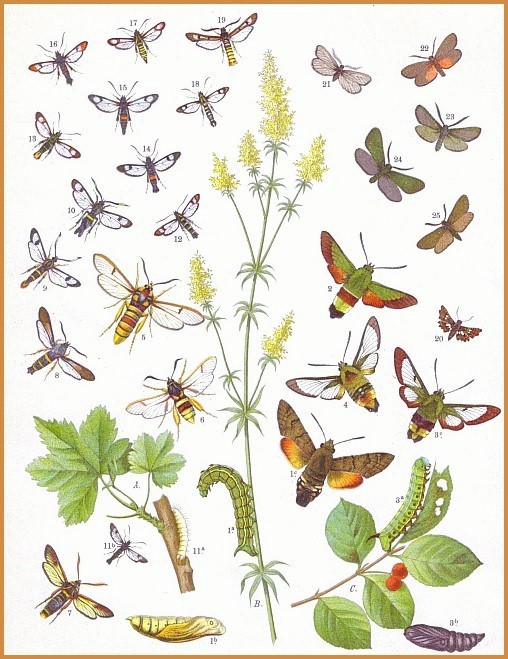
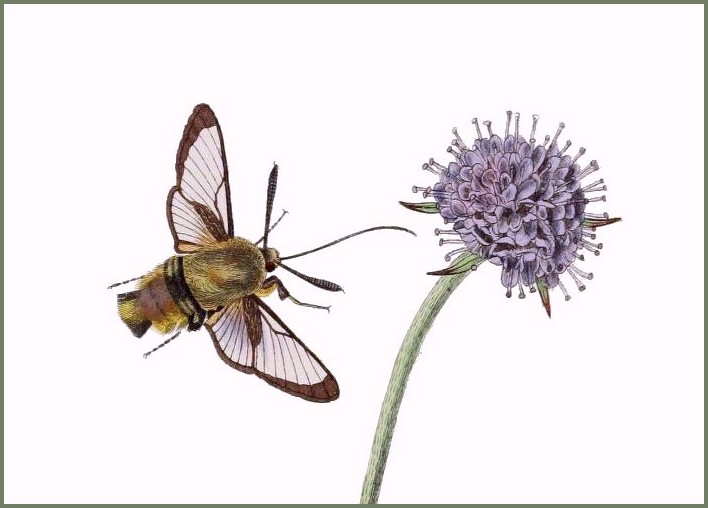
Holarctic; Palaearctic (both eastern and western). Pleistocene refuge: Polycentric -- Adriatomediterranean and Pontomediterranean subsections of the Mediterranean refuge, and the Caspian, Iranian, Turkestan, Nepali and Manchurian refugia.
Wingspan: 40--50mm. Distinguished from Hemaris fuciformis (Linnaeus, 1758) by the narrow band of scaling along the outer margin of each wing and the presence of an undivided forewing cell. Although some confusion may arise with freshly-emerged examples which have their entire wings covered with loose, grey scales, these are lost after the first flight, after which identification is made easier by a near absence of variation.
In the male genitalia, uncus and gnathos as in Hemaris fuciformis. Juxta rough with granules only apically, produced into a slender lobe. Valves asymmetrical; left valve broader than in Hemaris fuciformis, not spatulate, right valve narrowed in apical third. Left harpe represented by an obvious setose hump, evenly and broadly convex or flat; right harpe almost straight, apically clubbed and apically armed with spines. Phallus process longer than in Hemaris fuciformis, acutely pointed. In the female genitalia, antrum quite small, approximately square with rounded corners. Ductus bursae distinct, separating the antrum from the corpus bursae.
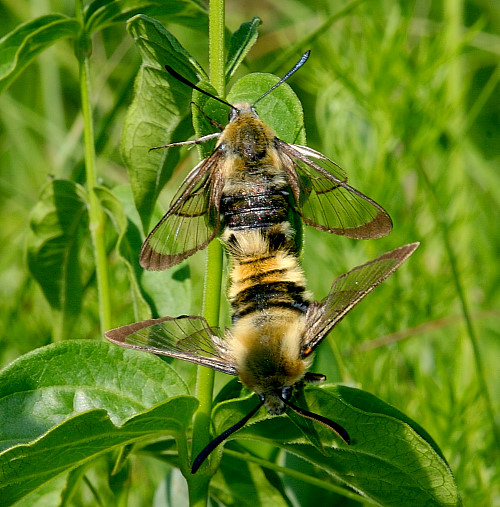
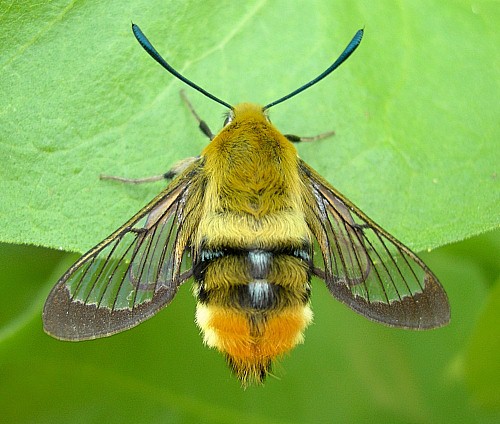
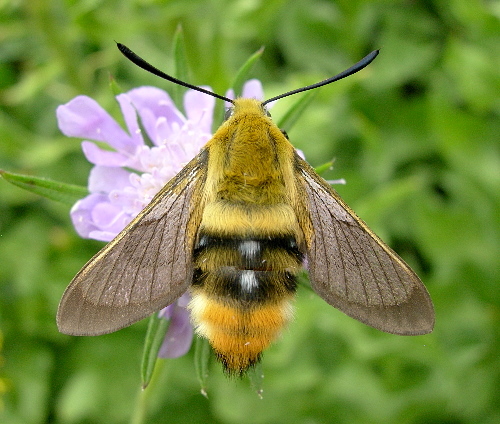
Diurnal. An insect of meadows, roadside verges and woodland glades rich in flowers, especially on chalk and sand where Ajuga (bugle) thrives. In such localities, vast numbers can be found in some years but very few in others, though it is never totally absent. Where this species occurs, Scabiosa (scabious) is nearly always present; however, many areas rich in this plant are devoid of Hemaris tityus. Up to 2000m in the Alps (Vorbrodt & Müller-Rutz, 1911; Forster & Wohlfahrt, 1960), even higher (3300-3600m) in Kyrgyzstan (Eitschberger & Churkin, 2002).

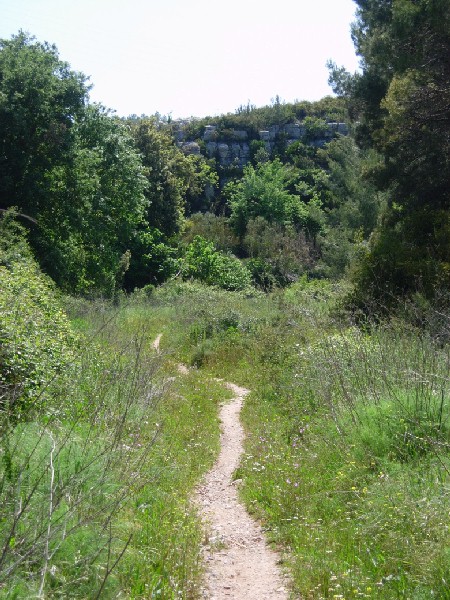
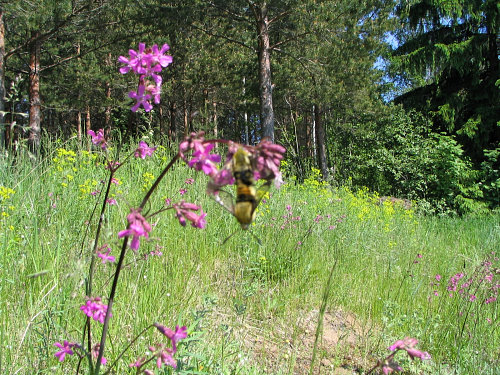
Unlike most other sphingids, this species is active during the day, generally between 10.00 and 15.00 hours, when it can be seen flitting rapidly from flower to flower of its favourite plants -- Ajuga, Glechoma, Lychnis, Viscaria, Salvia, Pulmonaria and Knautia (Bergmann, 1953). Although mimicking a bumble bee in coloration, its flight is much more rapid and agile. Its skill is superbly demonstrated during courtship when pairs chase each other low over the ground as well as spiralling upwards like a whirlwind. Copulation generally follows, with pairs remaining in copula for up to two hours.
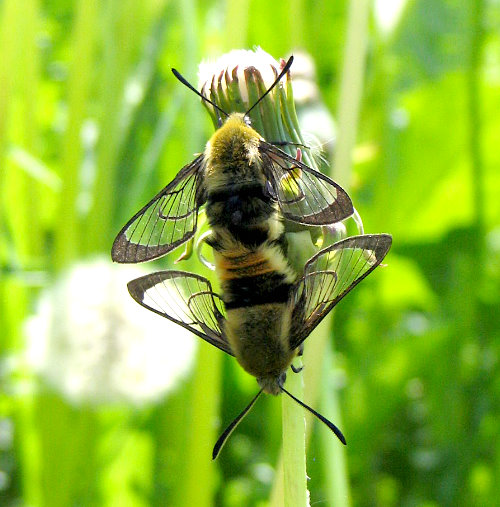
Mainly univoltine in northern Europe, mid-May to mid-June (sometimes early July) with an irregular partial second brood in August. Fully bivoltine farther south, during late April or early May, and again in August. Around Saratov, Russia, this species flies in June and July (Kumakov, 1977).
Late June (29-30.vi) in Kyrgyzstan at 3300-3600m (Eitschberger & Churkin, 2002), but mid May (13.v) in western Mongolia at 2000m (Yakovlev & Doroshkin, 2005). July only in the Altai Mountains (Kondratiev coll., NHMUK). However, in the mountains of Central Asia the flight-time varies with altitude.
OVUM: Small (1.1 x 1.0mm), almost spherical, with a small depression on top; pale glossy green. Laid singly on the underside of a leaf of the hostplant, with up to six per plant or group of plants not uncommon.
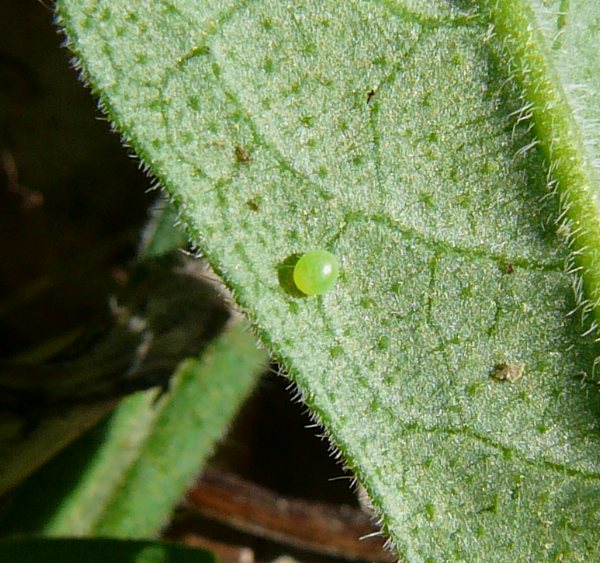
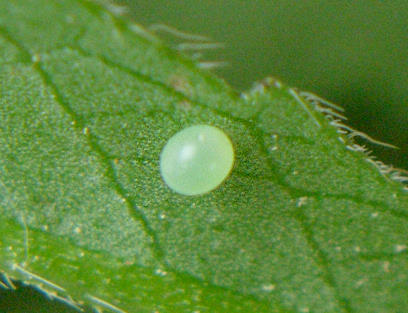
LARVA: Full-fed 50mm.
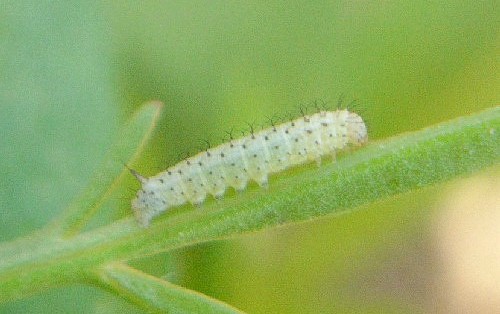
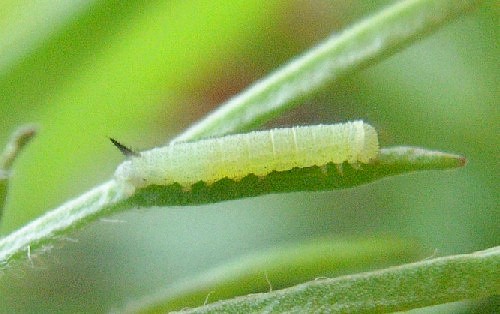
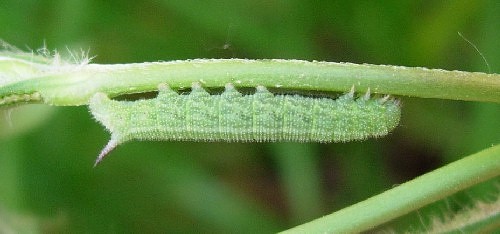
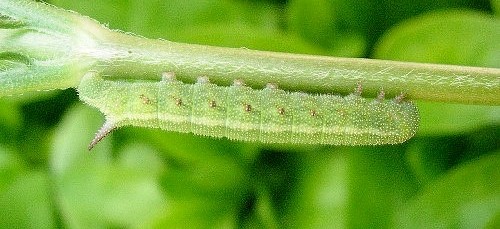
The newly-hatched, white larva is about 3mm long and covered with small black tubercles bearing forked, black hairs. The caudal horn is small with two black hairs at its apex. With each moult and feeding the body and tubercles gradually become green, the horn redder, and pale dorso-lateral and ventro-lateral lines appear along the side. Fully grown, most are whitish green with a dull red horn, purple-red ventral surface and with purple-red surrounds to the spiracles. The body is very rough to the touch. Many are heavily spotted with additional reddish blotches, especially those feeding on purple-spotted scabious leaves. When fully grown, such blotches are masked as the larva turns a rich plum colour prior to pupation.
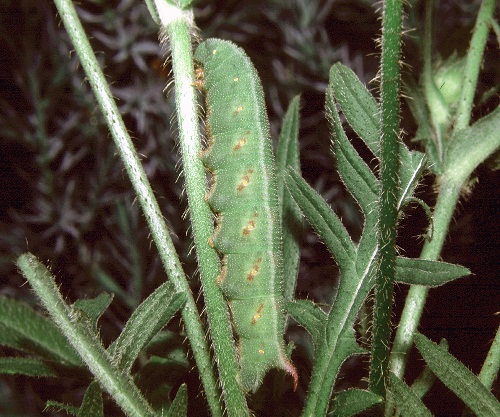
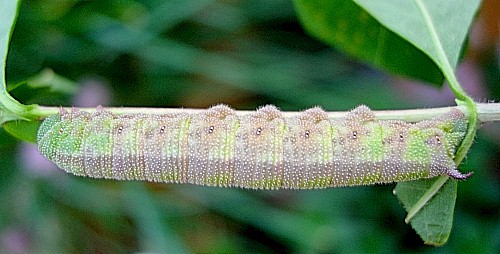
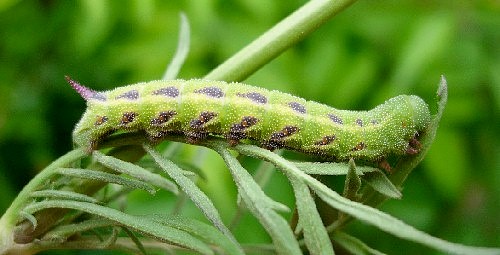
Throughout its life, the larva generally remains beneath a leaf, nibbling holes on either side of the midrib on which it rests. Most active at night; if disturbed during the day, it will drop to the ground, many even taking shelter there when not feeding. A noteworthy feature of this species is the variation in growth-rate of larvae of the same brood; however, all tend to mature much more rapidly than those of other sphingids.
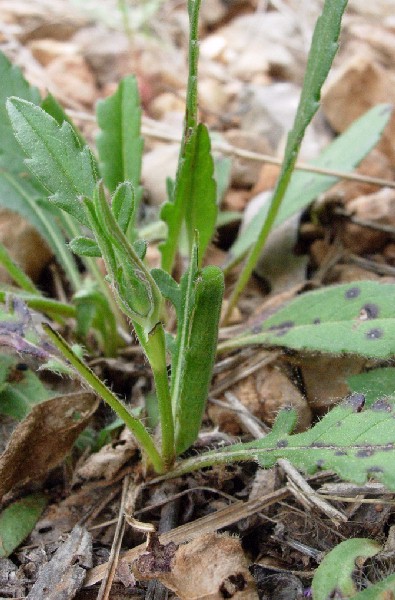
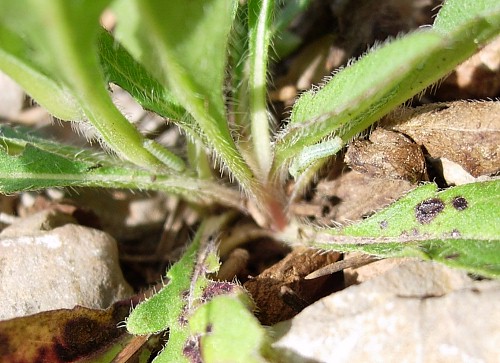
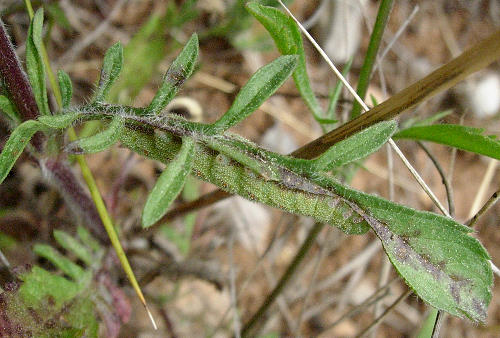
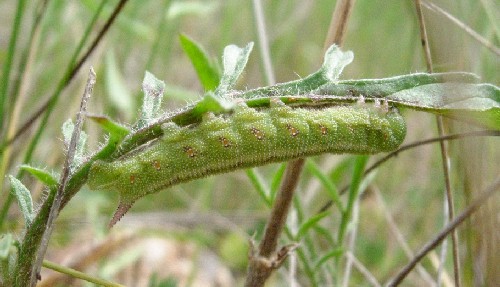
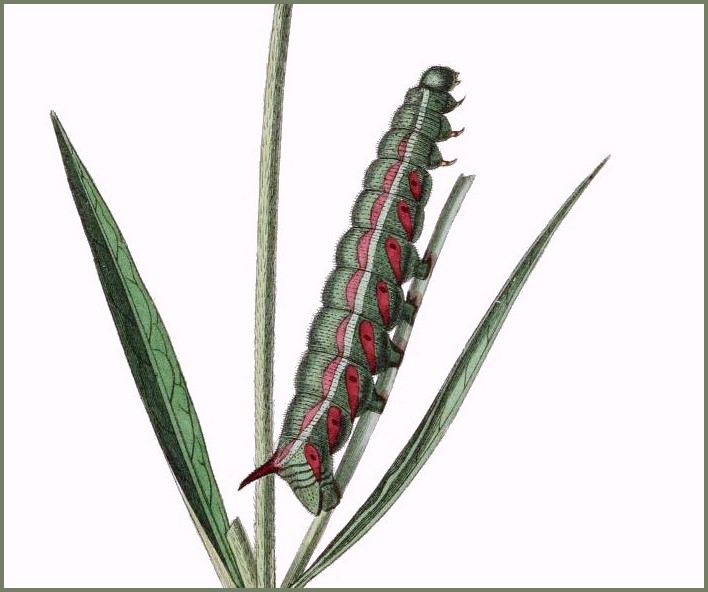
In Finland and other parts of northern Europe usually found in June-July; in the warmest parts of its range, from May to September.
Major Hostplants. In northern and central Europe, Succisa pratensis and Knautia arvensis.
Minor Hostplants. Species of Scabiosa, Galium, Lonicera, Symphoricarpos, Dipsacus and Lychnis. Reports of Centaurea (Marttila et al., 1996) require confirmation, but seem unlikely.
PUPA: 24--27mm. Typically Hemaris in shape but blackish brown, tinted with reddish brown at the juncture of each segment. Body tapers at either end, with two sharp head tubercles and a flat triangular cremaster. Formed in a rather strong but coarse cocoon among grass tussocks, or slightly into the soil. The overwintering stage.
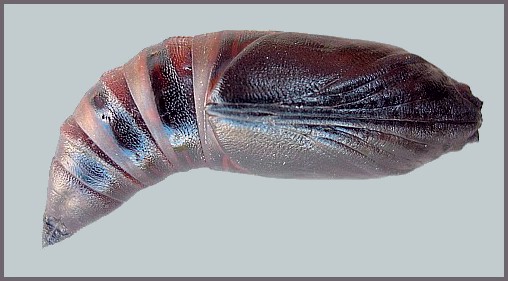
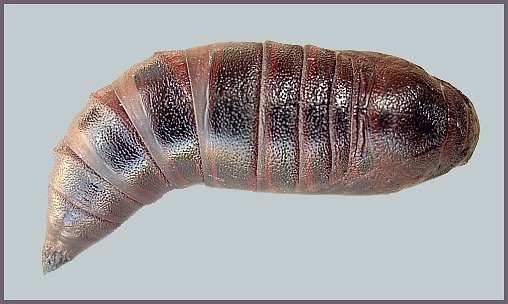
Tachinidae: Tachina praeceps Meigen, 1824.
From Ireland (Birchall, 1870; Lavery, 1991) across temperate Europe to the Urals (Eversmann, 1844; Kumakov, 1977), western Siberia (Knyazev, 2020), the Altai Mountains (Zolotarenko, Petrova & Shiryaev, 1978; Izerskiy, 1999), the Tian Shan of both western China and eastern Kazakhstan (Alpheraky, 1882; Eitschberger & Churkin, 2002; Toropov, Milko, Zhdanko & Evdoshenko, 2023), and Kyrgyzstan (Eitschberger & Churkin, 2002; Toropov, Milko, Zhdanko & Evdoshenko, 2023). Also, from Turkey (de Freina, 1979; Didmanidze, Petrov & Zolotuhin, 2013) to northern Iran (Brandt, 1938; Sutton, 1963), the Republic of Georgia (Didmanidze, Petrov & Zolotuhin, 2013), Armenia (Didmanidze, Petrov & Zolotuhin, 2013; Karagyan, Kalashian, Ghrejyan & Danchenko, 2019) and Azerbaijan (Didmanidze, Petrov & Zolotuhin, 2013; Snegovaya & Petrov, 2021). Absent from northern Scandinavia, most of arctic Russia, Portugal and the Netherlands, where it is now extinct (Meerman, 1987). Recorded as far north as Karelia (Kutenkova, Gorbach, Polevoi & Humala, 2015) and Pomozdino in european Russia (Tatarinov, Sedykh & Dolgin, 2003), as well as from Sicily (Parenzan & Porcelli, 2006) and most of the rest of Italy (Nardi & Spada, 2013; Parenzan & Porcelli, 2006).
Its extinction in the Netherlands coincides with the extinction of the butterfly Eurodryas aurinia (Rottemburg, 1775), which tends to share the same type of habitat (van Swaay, 1990). It has also declined in eastern Finland due to the loss of suitable dry habitats (Marttila et al., 1996). It is also declining rapidly in the UK due to habitat loss, although small local populations survive here and there (Hall, 2000).
Its distribution is patchy in Spain, where it occurs in the north, e.g. Galicia (Pino Pérez et al., 2009; Fernández Vidal, 2016) and around León (Torralba-Burrial & Outomuro, 2011), in a few central mountain refugia (Pérez De-Gregorio et al., 2001; Garre, Guerrero, Rubio & Ortiz, 2015), and in the southern Sierra Nevada of Almeria Province (Muñoz Sariot, 2014).
The records from Almeria Province, Spain, require further study as the population involved could be Hemaris aksana (Le Cerf, 1923).
Extra-limital range. From Novosibirsk and the Altai (Kondratiev coll., NHMUK; Izerskiy, 1999) eastward across the Tuva A.S.S.R. (Eitschberger et al., 2005) and the rest of southern Siberia to north-eastern China (Derzhavets, 1984) and southwards to Xizang Province/Tibet (Chu & Wang, 1980b), including Qinghai Province (Lake Qinghai), China.
This species is very sparodic and rare east of Novosibirsk.
None.
 Return to species list
Return to species list